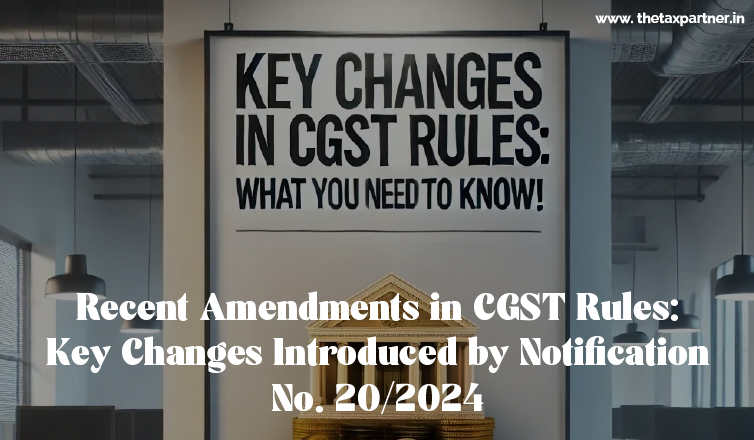Connect with us for all your queries



This article delves into the key amendments, analyzing the major changes and their implications for taxpayers and businesses. We will explore the modifications to various rules, such as Rules 36, 46, 47A, 66, 89, and 96, as well as the introduction of a new section, Section 74A, among others. By the end of this article, readers will have a comprehensive understanding of how these changes affect the GST compliance landscape.
One of the most critical amendments brought forth by Notification No. 20/2024 is related to Rule 36. This change focuses on the disallowance of Input Tax Credit (ITC) for demands confirmed under Section 74, which deals with fraud, willful misstatement, or suppression of facts.
Section 74 of the CGST Act provides for the determination of tax in cases where there is fraud, misstatement, or suppression of facts with an intent to evade tax. The proceedings under this section usually result in significant penalties and tax liabilities for the taxpayer.
The new amendment to Rule 36 clarifies that taxpayers who have confirmed tax demands under Section 74 will no longer be eligible to claim ITC on such liabilities. This change is designed to close the loopholes that previously allowed taxpayers to offset confirmed tax liabilities with ITC, effectively reducing their financial burden.
The disallowance of ITC in cases of fraud is a strong step towards ensuring tax compliance. It serves as a deterrent to those who might try to manipulate their tax positions by using fraudulent means, as it increases the financial repercussions of being caught.
Another significant amendment pertains to Rule 46, which governs the issuance of tax invoices. The notification omits the proviso that previously allowed consolidated invoices for supplies made to unregistered recipients.
Under the erstwhile Rule 46, businesses were allowed to issue a single, consolidated invoice for multiple supplies made to unregistered persons. This helped simplify the invoicing process for businesses, particularly those dealing with a large number of unregistered suppliers.
By omitting this proviso, the government has tightened the requirements for invoicing. Now, businesses must issue individual invoices for each supply made to unregistered recipients. This change, effective from November 1, 2024, aims to improve transparency and traceability of transactions, making it harder for businesses to manipulate their sales records.
For businesses, this means an additional administrative burden, as they will now have to ensure that each transaction is properly invoiced, even if the recipient is not registered under GST. On the positive side, it will improve compliance and reduce instances of tax evasion, which can occur through underreporting of transactions with unregistered entities.
The amendment introduces a new rule, Rule 47A, which mandates that invoices for supplies under the Reverse Charge Mechanism (RCM) must be issued within 30 days from the date of supply.
Under the Reverse Charge Mechanism, the liability to pay tax shifts from the supplier to the recipient of goods or services. This mechanism is typically applied in cases where the supplier is unregistered or in specific types of transactions as prescribed by the government.
The introduction of Rule 47A is aimed at streamlining the invoicing process for reverse charge transactions. The 30-day window ensures that the recipient, who is responsible for paying the tax, issues an invoice within a reasonable time frame. This change promotes timely compliance and minimizes delays in tax payments.
Businesses engaged in RCM transactions must now take note of this new requirement and ensure that they have systems in place to issue invoices within the specified time limit. Failure to do so could result in penalties or other compliance issues.
Rule 66 has been amended to mandate that TDS returns (Form GSTR-7) must be filed by the 10th of the following month. This change is effective from November 1, 2024.
Previously, the deadline for filing TDS returns was the 20th of the following month. This gave businesses and tax deductors more time to file their returns. However, the government has now shortened this timeline, requiring returns to be filed within 10 days.
This amendment aims to expedite the collection of taxes and ensure that tax credits are available to deductees sooner. By moving the deadline forward, the government can improve the overall efficiency of the tax system. However, businesses that deduct TDS will now need to be more diligent in their filing practices to avoid penalties for late submission.
Rule 89, which deals with refund claims, has been amended by omitting sub-rules (4A) and (4B). These sub-rules pertained to specific refund claims for zero-rated supplies and inverted duty structures.
Sub-rule 4A allowed for a refund of unutilized ITC in cases of zero-rated supplies (exports).
Sub-rule 4B provided for a refund in cases where the tax rate on inputs was higher than the tax rate on outputs (inverted duty structure).
The omission of these sub-rules simplifies the refund process by removing specific provisions. Exporters and businesses dealing with inverted duty structures will now have to follow the general refund provisions outlined in the CGST Rules.
While this change reduces the complexity of the refund process, it also means that businesses that previously benefitted from these specific provisions may now face delays or challenges in claiming refunds. It remains to be seen how this amendment will impact refund processing times and the overall ease of doing business.
Rule 96, which deals with the refund of Integrated GST (IGST) on exports, has been amended to remove restrictions on claiming IGST refunds when input tax exemptions have been availed.
Earlier, businesses that availed of input tax exemptions under certain provisions were not eligible to claim IGST refunds on their exports. This restriction was designed to prevent double benefits.
With the removal of this restriction, businesses can now claim IGST refunds even if they have availed of input tax exemptions. This is a welcome move for exporters, as it simplifies the refund process and promotes exports by improving cash flow.
For businesses engaged in international trade, this change represents a significant relief, as it removes a major bottleneck in the refund process. Exporters can now look forward to quicker refunds and better liquidity, which will help them remain competitive in global markets.
The notification introduces a new procedure for the waiver of interest and penalties under Section 73, which deals with the determination of tax not involving fraud or suppression of facts. This procedure is laid out in Rule 164, and forms have been introduced to facilitate the waiver process.
Section 73 allows taxpayers to request a waiver of interest and penalties in cases where the tax shortfall was due to a genuine error or misunderstanding, and not due to fraud or willful evasion.
The introduction of Rule 164 provides clarity and structure to the waiver process, making it easier for taxpayers to apply for relief. By formalizing the procedure and introducing specific forms, the government aims to ensure that waivers are granted in a fair and transparent manner.
This change is beneficial for taxpayers who may have inadvertently underreported their taxes. It provides them with a clear path to seek relief from interest and penalties, thereby reducing their overall tax burden.
A new section, Section 74A, has been introduced to distinguish between tax determination in cases involving fraud and non-fraudulent errors. This section, applicable from FY 2024-25, seeks to provide a more balanced approach to tax assessments.
Differentiates between genuine errors and fraudulent activities.
Provides separate procedures for determining tax liabilities in each case.
The introduction of Section 74A is a step towards a more taxpayer-friendly system, as it ensures that those who have made genuine mistakes are not penalized as harshly as those who have committed fraud. This change is expected to encourage greater voluntary compliance, as taxpayers will feel more confident that their errors will be treated fairly.
Several GST forms, including GST REG-20, GSTR-9, and INS-01, have been updated to align with the changes introduced by Notification No. 20/2024. These updates are designed to streamline the compliance process and make it easier for businesses to file their returns and fulfill their tax obligations.
Businesses will need to familiarize themselves with the updated forms and ensure that their systems are updated accordingly. These changes are expected to reduce errors and improve the accuracy of filings, thereby enhancing overall compliance.
The table below summarizes the key amendments introduced by Notification No. 20/2024 – Central Tax:
.png)
The amendments introduced by Notification No. 20/2024 – Central Tax mark a significant step towards enhancing compliance, curbing fraud, and simplifying processes under the GST regime. These changes, which range from stricter ITC disallowances to improved invoicing procedures and refund mechanisms, reflect the government's commitment to creating a transparent and efficient tax system.
For businesses and taxpayers, these amendments underscore the importance of staying up-to-date with the latest compliance requirements. By understanding and implementing these changes, businesses can not only avoid penalties but also take advantage of the streamlined processes to improve their overall tax management.
As these amendments come into effect, businesses are advised to review their current practices and make the necessary adjustments to ensure smooth compliance with the new rules. In doing so, they can navigate the evolving GST landscape with confidence and clarity.
Tax Partner is India’s most reliable online business service platform, dedicated to helping you in starting, growing, & flourishing your business with our wide array of expert services at a very affordable cost.